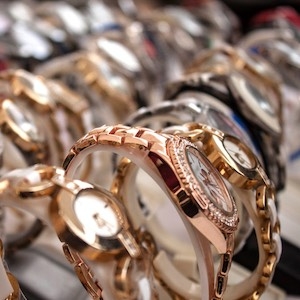
The “big four” private watch brands—Rolex, Patek Philippe, Audemars Piguet, and Richard Mille—all gained market share in 2023, while several conglomerate-owned brands lost ground, according to Morgan Stanley’s seventh annual “Swiss Watcher” report, compiled in conjunction with LuxeConsult.
Together, the four nonpublic brands claimed 43% of the market, up from 41.9% in 2022, and 36.9% in 2019.
For those four watch lines, “desirability is near an all-time high,” wrote the study’s authors, “as evidenced by a further lengthening in waiting lists, although we note that premiums in the secondhand market have come down in recent months.”
The continued popularity of independently owned watch brands is unique “within the broader luxury goods sector,” the report added. “In most other verticals, listed groups are gaining share.”
The three major public companies active in the timepiece business—Richemont, LVMH, and Swatch Group—all lost market share in 2023, with Swatch dropping the most, despite strong results from Tissot and its flagship Swatch brand, according to the report. LVMH saw “soft” performance from Hublot and TAG Heuer, while Richemont’s results were mixed: Vacheron Constantin delivered a “solid” performance, and Cartier’s sales were “respectable,” but other Richemont watch brands—IWC, Panerai, Jaeger-LeCoultre, and Piaget—underperformed.
Rolex commanded the largest share by far of the watch market, an estimated 30.3%. Its lead was so great that its 2023 sales topped those of the five runners-up combined. Cartier and Omega (owned by Richemont and Swatch, respectively) grabbed second place, each with a 7.5% market share. Patek Philippe accounted for 5.6% of the market; Audemars Piguet, 4.9%; and Richard Mille, 3.1%.
“No other luxury brand [other than Rolex] can claim such a dominant position in its respective sector,” wrote the analysts. “For example, we estimate that Louis Vuitton had a market share of [around] 19% in the luxury handbag market last year.”
The report also contained estimates on jewelry sales. Cartier and Van Cleef & Arpels gained market share last year, but Tiffany, purchased by LVMH in 2021, was “likely experiencing sales contraction year-over year.”
Morgan Stanley/LuxeConsult predicted watch brands will continue to shrink their wholesale distribution, with Rolex’s 2023 purchase of the Bucherer retail chain a sign that “the Crown” wants tighter control of its retail network. The report predicted the watch giant will eventually cull 20% of its 1,560 sale locations. Patek Philippe has also been trimming its retail channel, and the report forecast it will either partner with Rolex at Bucherer or open its own salons.
Overall, high-end timepieces did far better than less expensive models last year, except for Tissot and Swatch. The weak results on the low end are partly due to smartwatches, the analysts asserted: In 2023, approximately 80 million smartwatches were sold worldwide, compared with 16.9 million exports of Swiss watches.
“Watches with a retail price tag exceeding 25,000 [Swiss francs] accounted for 69% of the growth and 44% of the total value of Swiss watch exports,” the report said. “But this segment represents only 2.5% of the total volume in units.”
(Photo: Getty Images)
- Subscribe to the JCK News Daily
- Subscribe to the JCK Special Report
- Follow JCK on Instagram: @jckmagazine
- Follow JCK on X: @jckmagazine
- Follow JCK on Facebook: @jckmagazine







